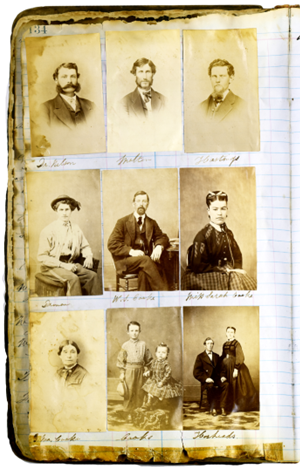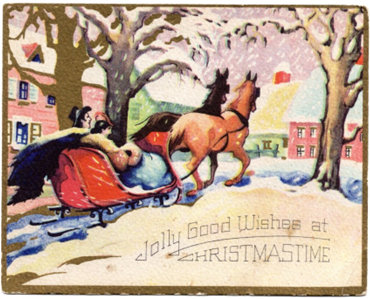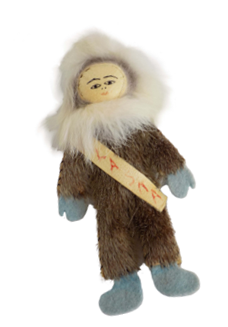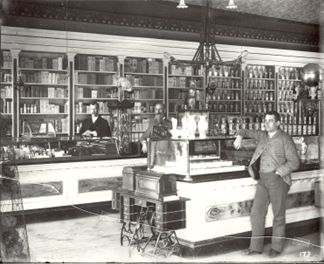Administrator’s Notes
Ralph Gibson, Museums Administrator
This will be my 20th year with the Placer County Museums. My first official day was October 16, 2004. It was a Saturday, and I was the newly hired Curator of Education. Ten years later, in March of 2014, I officially became Museums Administrator. So this is a year of personal milestones, but it’s also an ambitious year for our museums. Staff will be busy planning, designing and installing new exhibits at the Forest Hill Divide, Gold Rush and Placer County Museums. We also hope to keep the record-breaking attendance figures for our Community Education programs going and we hope for another great summer of The Heritage Trail.
And behind the scenes of all these public-facing projects and events, staff will be working tirelessly to process two huge collections that were donated to the Placer County Museums in the latter half of 2023. After her sudden and untimely passing, Karri Samson’s incredible collection of local history was donated as was the entire collection of the Gold County Medical History Museum, which closed their doors for good last summer.
So yes, 2024 will be a busy, fun, and productive year.
 |
Ralph Gibson , Carol Cramer, Nancy Kennedy, Brenda Starbird, and Sandi Tribe at the Bernhard Museum in 2006. |
Message from the Editor
I am thrilled to extend a warm greeting to all of you as the newly appointed editor of The Placer newsletter. It is an honor to embark on this exciting journey of curating, crafting, and delivering content that will captivate and inspire our valued readers. I hope that The Placer will be a space where you can find thought-provoking articles and engaging stories that cater to your interests and curiosity and reflect the vibrancy of our museum community.
Since our first issue in 1985, we continue to welcome your contributions of upcoming events, organizational news, and short articles on historical topics. To stay connected and be part of the conversation, please make sure to follow us on Facebook and Instagram and share your thoughts by e-mail (Museums@ placer.ca.gov). Your input is vital in shaping the future content of the newsletter. Submissions for the next issue are due by February 15.
Best regards,
Kasia Woroniecka, Curator of Collections
New Donation Highlight
by Kasia Woroniecka, Curator of Collections
We received a new donation and a glamorous addition to Placer County Museums collection—a beautiful flapper dress featuring an oversized bow. This magnificent piece captures the essence of the Roaring Twenties and adds a touch of elegance to our ever-growing collection. It dates to the 1920s and belonged to Effa Lardner Gordon, daughter of W. B. Lardner, a prominent Auburn attorney and state senator.
It is through donations like these that we can continue to bring history to life for our visitors. If you have items with Placer County history that you are interested in donating, please contact the Curator of Collections, Kasia Woroniecka (kworonie@placer.ca.gov) or the Curator of Archives, Kelsey Monahan (kmonahan@placer.ca.gov) to find out how.
Dear Diary...
by Kelsey Monahan, Curator of Archives
I am very excited to share that the I.T. Coffin Diaries, a part of the Golden Drift Historical Society Collection, have been accepted into the California Revealed Digitization & Preservation Assistance Program for 2024! This important initiative by the State Library aims to help heritage organizations digitize and preserve collections significant to California's rich history, covering everything from old books to newspapers and even audiovisual recordings. The Placer County Museums Division has been fortunate to have participated in this program previously, and you can find our digitized collections at: https://californiarevealed.org/partner/placer-county-museums-division/
The I.T. Coffin Diaries, named after Isaac Tibbetts Coffin, offer valuable insights into the Dutch Flat area during critical periods of its history. Born on November 20, 1832, in Tuftonboro, New Hampshire, Coffin arrived in California in 1856 during the Gold Rush and eventually settled in Placer County in 1858. In addition to mining, he also worked as the owner of the Dutch Flat Water Works, ran a photography studio, and actively participated in fraternal orders.
Spanning the years 1863 and the period from 1870 to 1885, the diaries provide a comprehensive view of Coffin's experiences. The 1863 diary, a pocket-sized journal, documents the challenges and triumphs faced by a gold miner during a transformative phase in California's gold mining history, marked by the adoption of new techniques like hydraulic mining. Coffin's reflections not only cover the technical aspects of mining but also provide a personal and emotional perspective, offering a glimpse into the hardships, daily monotony, and conflicting emotions associated with being distant from home.
The second diary, spanning from 1870 to 1885, has entries that offer insight into the challenges and successes Coffin faced while operating his businesses, as well as insights into his family life and the social fabric of Dutch Flat. This diary is unique in that it goes beyond just written accounts and includes portrait photographs, presumably taken by Coffin himself in his photography studio. These portrait photographs of Dutch Flat residents give us a tangible connection to the individuals of his community.
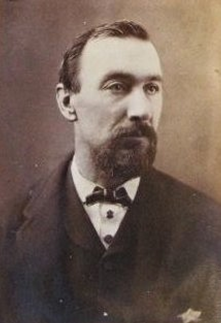 |
I. T. Coffin |
Through digitization, these historical diaries can be made readily accessible to a wide audience, including students, researchers, and the general public around the world. This virtual accessibility will enable individuals who lack the physical means to visit our museums or research center the opportunity to engage with and study this primary source firsthand, enriching their understanding of Placer County and California's history.
Docent Spotlight
by Katy Bartosh, Curator of Education
The Placer County Museums operate with the help of over 150 active volunteers. With dedication and enthusiasm, these amazing docents help us keep eight museums open by filling an average of 160 calendar openings every month. This new quarterly column will feature some of our great docents; who they are and how they came to volunteer with us. I caught Kathy Fox and Brad Weisberg at the Bernhard Museum for our Inaugural highlight!
 |
Kathy Fox and Brad Weisberg |
Kathy Fox, docent class of 2021
Q: What did you do before you were a docent?
A: I had completed a Master’s Degree in Library and Information Science with a focus in Archival Studies and was working as an Administrative Assistant/Librarian in Special Collections at the San Jose State University Library. When I retired, I moved to Auburn to be close to my family. I’ve had a broad range of jobs in my long working life including making root beer at an A&W Drive-In to working for a Forensic Odontologist (Google it!).
Q: Why did you become a docent?
A: I became a docent at the suggestion of my sister Gayle. We both were looking for a way to give back to our community.
Q: What museums do you docent at and why?
A: After “trying out” several of the museums I knew that the Bernhard House was an ideal fit for me in so many ways. I’m a third generation Californian and grew up learning the history of the state. Here was an opportunity to delve deeper into that history. I am a storyteller. I love learning beyond the basic facts and weaving that material into a narrative that I can share with museum visitors.
Q: What’s a fun fact about you?
A: Fun fact about me is that I play the tenor ukulele. I play and sing weekly with a ukulele group. Got ukulele?
Brad Weisberg, docent class of 2023
Q: What did you do before you were a docent?
A: I just retired after a 25 year career in education. I was hired as a tenured faculty member in the Theatre program at West Valley College in Saratoga CA. I spent 17 years in the program and served as department chair for 6 of those years. The last 8 years of my career I spent as Dean of Career Programs and Workforce Development. Before getting hired at West Valley, I was a stage designer and technical director for a professional theatre company in the Bay Area. I have spent almost 50 years in the theatre as an actor, director, designer and educator and I hold a Masters Degree in Theatre History from San Diego State University.
Q: Why did you become a docent?
A: I have always loved history and I still love talking to people. I remember taking vacations with the kids during the summer and visiting places that used docents. I thought that kind of job was right up my alley! Being able to share my enthusiasm for history with people who are interested is a perfect fit for someone with my skill set.
Q: What museums do you docent at and why?
A: I have worked at the Gold Rush museum, the County museum and The Bernhard complex. Of those (although all three are amazing) I prefer the Bernhard. My fascination with that museum stems from the days when it was known as the Traveler's Rest Inn. The thought of hundreds or thousands of would-be gold miners passing by the front doors of this establishment in 1851 - maybe stopping for the night. The rich history of the complex makes it a unique experience for visitors and I love being able to share that with people.
Q: What’s a fun fact about you?
A: I have found my next obsession and that is historical re-enactment. I was so fortunate to be able to play Rattlesnake Dick in the Auburn cemetery tour this past October. Combining my love of history, research and performing. I hope to do much more of this in the future!
Placer County Historical Society Dinner Meeting
Meeting at 6:00, Dinner at 6:15, Speaker Michael Lynch at 6:45
Location: Veterans Memorial Hall Cost: $20.00
100 East Street, Auburn, CA
Please RSVP to Jane Hamilton by January 25, 2024: hamiltonjane1@me.com or 530-885-7839
Please go to www.placercountyhistoricalsociety.org for more information
Placer County Historical Organizations Calendar
Please confirm all meeting times and locations which each organization
Foresthill Divide Historical Society Meeting: Monday, January 15th at 6:00 p.m.
Golden Drift Historical Society Meeting: Monday, February 5th at 7:00 p.m.
Historical Advisory Board Meeting: Wednesday, February 21st at 5:30 p.m.
Loomis Basin Historical Society Meeting: Wednesday, February 21st at 6:00 p.m.
Placer County Historical Society Meeting: Thursday, January 4th at 2:00 p.m.
Placer Sierra Railroad Heritage Society: Tuesday, February 23rd at 7:00 p.m.
Placer Genealogical Society Meeting: Monday, January 22nd at 7:00 p.m.
Rocklin Historical Society Meeting: January 8th at 6:00 p.m.
Roseville Historical Society Meeting: January 9th at 4:00 p.m.
Placer County Historical Organizations
Dirk Gifford, (530) 346-8599
colfaxhistory.org
Bill Oudegeest
(209) 606-6859
donnersummithistoricalsociety.org
Foresthill Divide Historical Society
Fruitvale School Hall Community Association
Mark Fowler
Sarah Fugate
(530) 389-2121
Historical Advisory Board
Glenn Vineyard
(916) 747-1961
Joss House Museum and Chinese History Center
Larry Finney
(530) 305-9380
Lincoln Area Archives Museum
Elizabeth Jansen
(916) 645-3800
laamca.org
Lincoln Highway Association
Trey Pitsenberger
Loomis Basin Historical Society
Karen Clifford
(916) 663-3871
ppgn.com/loomishistorical.html
Maidu Museum & Historic Site
Kaitlin Kincade
(916) 774-5934
roseville.ca.us/indianmuseum
Native Sons of the Golden West Parlor #59
Dave Allen
(530) 878-2878
dsallen59@sbcglobal.net
Newcastle Portuguese Hall Association
Mario Farinha
(530) 269-2412
North Lake Tahoe Historical Society
(530) 583-1762
northtahoemuseums.org
Old Town Auburn Preservation Society
Lynn Carpenter
(530) 885-1252
Placer County Genealogical Society
Diane Fishburn
http://www.placergenealogy.org
Placer County Historical Society
April McDonald-Loomis(530) 823-2128
placercountyhistoricalsociety.org
Placer County Museums Docent Guild
Craig Norris
Placer Sierra Railroad Heritage Society
Chuck Spinks
chuck.spinks@outlook.com
Rocklin Historical Society
rocklinhistorical@gmail.com
rocklinhistory.org
Roseville Historical Society
Denise Fiddyment
(916) 773-3003


